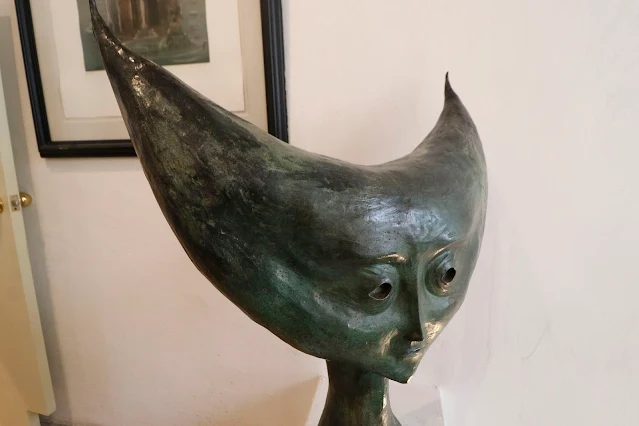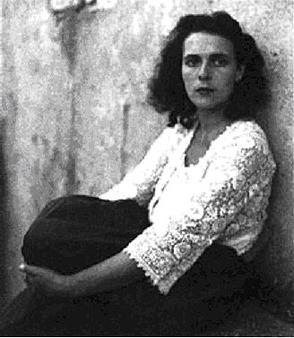Leonora Carrington: The Surrealist Visionary Who Redefined Art and Feminism
Leonora Carrington (1917–2011) was not just a surrealist artist—she was a revolutionary voice who used her creativity to challenge societal norms, patriarchal narratives, and artistic conventions. Though often categorized alongside surrealist greats like Salvador Dalí and Max Ernst, Carrington’s work defies simple classification. Her unique blend of mysticism, feminism, and surrealism makes her one of the most compelling and underappreciated figures in modern art.
In this in-depth article, we explore Leonora Carrington’s biography, her artistic evolution, literary contributions, feminist symbolism, and her lasting influence on contemporary culture.
.jpg)
Photo by Gobierno de México, licensed under CC BY 2.0, via Wikimedia Commons.
Early Life: Born into Wealth, Drawn to Rebellion
.jpg)
Leonora Carrington was born in Lancashire, England, into a wealthy family. From a young age, she showed a rebellious streak, resisting the strict Catholic upbringing and upper-class expectations placed upon her. She was expelled from multiple schools for nonconformity and eventually studied art in London and Florence.
It was clear early on that Carrington was drawn to imagination and independence rather than tradition. Her early exposure to Celtic mythology, fairy tales, and esoteric traditions would later serve as the foundation of her surrealist vision.
Surrealism and Max Ernst: Love, Art, and Trauma
.jpg) |
Photo by Gobierno de México, “Casa Estudio Leonora Carrington,” licensed under CC BY 2.0, via Wikimedia Commons. |
Carrington’s encounter with German surrealist Max Ernst in 1937 was a turning point in her life. The two formed a romantic and artistic partnership and moved to Paris, where she joined the circle of surrealist artists including André Breton and Marcel Duchamp.
During this period, Carrington created dreamlike paintings full of symbolic creatures, mythological references, and personal iconography. One of her early masterpieces, "The Inn of the Dawn Horse" (1939), is a self-portrait that depicts her as both human and animal—independent, strong, and enigmatic.
However, their time together was disrupted by the onset of World War II. Ernst was arrested by the Nazis for his "degenerate art," and Carrington fled to Spain, where she suffered a severe mental breakdown and was institutionalized. Her experiences during this traumatic time would later shape both her art and her writing.
Exile in Mexico: A New Chapter of Creative Freedom
After escaping Europe, Carrington eventually settled in Mexico City, a place she called home for the rest of her life. In Mexico, she found a new sense of belonging among fellow exiled artists and writers, including Remedios Varo and Kati Horna. This community allowed her to fully explore her surrealist vision free from the male-dominated narratives of European surrealism.
Carrington’s work in Mexico is some of her most powerful and original. Her paintings became increasingly complex, often featuring magical creatures, celestial beings, and alchemical transformations. Works like "The Lovers" (1947) and "The Pomps of the Subsoil" (1947) showcase her signature style: a mystical, feminine surrealism rooted in transformation and transcendence.
The Hearing Trumpet and Literary Legacy
In addition to painting, Leonora Carrington was also a prolific writer. Her most famous literary work, "The Hearing Trumpet", published in 1974, is a surrealist novel about a 92-year-old woman who uncovers a magical conspiracy in a strange retirement home. Blending humor, fantasy, and feminist themes, the novel exemplifies Carrington’s unique voice—bold, eccentric, and wise.
She also wrote short stories, plays, and essays, many of which explore themes like madness, transformation, and matriarchy. Her stories are rich with symbols and metaphors drawn from mythology, alchemy, tarot, and folklore.
.jpg)
Photo by Gobierno de México, “Casa Estudio Leonora Carrington,” licensed under CC BY 2.0, via Wikimedia Commons.
Feminism and Symbolism in Carrington’s Work
.jpg)
Photo by Gobierno de México, “Casa Estudio Leonora Carrington,” licensed under CC BY 2.0, via Wikimedia Commons.
Leonora Carrington’s art and writing are deeply feminist, even though she never labeled herself explicitly as such. Her female figures are never passive or objectified. Instead, they are witches, warriors, shapeshifters, and wise women—archetypes that resist male gaze and dominance.
She often painted women in the company of animals or surrounded by magical energy, symbolizing a connection to nature, intuition, and power. Her canvases subvert traditional gender roles and present an alternative cosmology in which the feminine is sacred, wise, and transformative.
In many ways, Carrington anticipated the themes of second-wave feminism and eco-feminism decades before they entered mainstream discourse.
Recognition and Legacy: Finally Getting Her Due
For many years, Carrington was overlooked in the male-centric narrative of surrealism. She was often referred to as “Max Ernst’s muse” rather than an artist in her own right. However, in recent decades, art historians, feminists, and institutions have finally begun to recognize her genius.
Major retrospectives have been held at museums around the world, including the Tate in London and the Museo de Arte Moderno in Mexico City. In 2022, the opening of the Leonora Carrington Museum in San Luis Potosí, Mexico, marked a major milestone in honoring her legacy.
Today, she is celebrated not just as a surrealist but as a pioneer of feminist art, a master of magical realism, and a trailblazer for women in the creative arts.
Conclusion: Why Leonora Carrington Matters Today
Leonora Carrington’s life and work continue to resonate with audiences seeking authenticity, empowerment, and imagination. Her art speaks to the hidden corners of the psyche, the wisdom of the feminine, and the freedom of not fitting into society’s molds.
As more people discover her paintings and stories, her influence grows—spanning across visual arts, literature, feminist theory, and even contemporary fashion and media.
In a world that still tries to box people into categories, Carrington reminds us that true creativity comes from breaking those boxes apart. She didn’t just make surrealist art—she lived a surrealist life, full of risk, transformation, and magical resistance.
Keywords: Leonora Carrington, surrealist artist, feminist art, women in surrealism, surrealist paintings, magical realism, The Hearing Trumpet, Max Ernst, Mexico surrealism, Leonora Carrington biography
Sources:
-
Tate Gallery – Leonora Carrington
-
"The Surreal Life of Leonora Carrington" by Joanna Moorhead
-
Museo de Arte Moderno, Mexico
-
Carrington, L. (1974). The Hearing Trumpet

Comments
Post a Comment